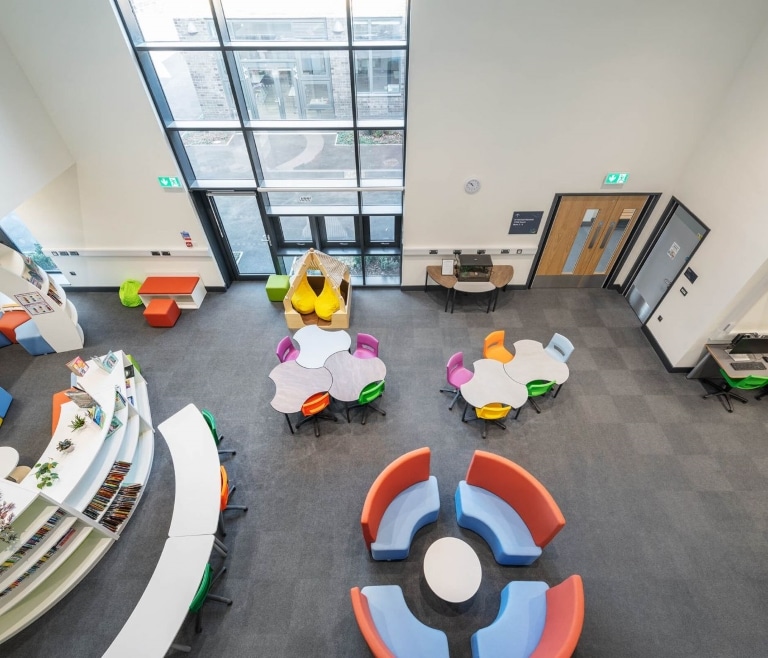Creating Learning Zones in the Classroom | Westcountry Group
Dec 6, 2023 • 5 minutes

Step into a modern UK classroom, and you may find yourself stepping into a whole new world of learning. The traditional rows of desks focused on the teacher are giving way to dynamic, interactive spaces. With classroom designers harnessing the power of technology and innovative teaching methods, these new environments are reshaping the educational landscape and revolutionising the way students learn. From areas where they can collaborate on projects at shared tables, engage in hands-on experimentation at designated stations, to exploring digital resources through interactive displays, mixed learning zones provide versatile areas within a single classroom that cater to various learning styles and activities.
Setting Up the Classroom Environment
Creating mixed learning zones in the classroom involves designing a dynamic environment that caters to a variety of needs. By setting up different areas for individual work, group collaboration, and hands-on activities, students can engage with the material in diverse ways.
Central Teaching Spaces
Central teaching spaces, when combined with versatile teaching walls and whiteboards, can pave the way for interactive learning experiences. By incorporating these elements into the classroom environment, educators can foster creativity and engagement.
The strategic placement of teaching walls can facilitate group discussions and brainstorming sessions, encouraging active participation from all students. The use of whiteboards as interactive tools allows for real-time idea generation and information sharing. This innovative setup not only empowers teachers to deliver impactful lessons but also fosters a sense of ownership among students as they take control of their learning experiences.
Individual Study Spaces
Incorporating individual study areas, booths, and single desks, allows educators to cater to different learning needs and preferences within the same classroom environment. This approach allows students to have the flexibility to choose a space that best suits their current task or mood, fostering a sense of autonomy.
Individual study spaces provide a quiet and focused environment for students who thrive in solitude while working on academic tasks. Study booths offer a semi-private area where collaboration and peer interaction can take place without disturbing others. Meanwhile, individual desks are essential for traditional lecture-style teaching or independent work activities.
By integrating these diverse elements into the classroom layout, educators empower students to take ownership of their learning journey while encouraging self-directed learning habits.
Areas Dedicated to Group Discussions
Areas dedicated to group discussions facilitate teachers to encourage a more interactive and participative learning environment. Round tables offer opportunities for more equal social interaction, as students are positioned facing each other, fostering open communication and collaborative problem-solving.
This approach promotes peer-to-peer learning and facilitates the development of important social skills such as active listening, respectful communication, and teamwork.
Breakout Spaces
Breakout spaces offer the opportunity to learn in a more relaxed and comfortable environment, promoting creativity and collaboration. Replacing traditional rows of desks with cosy nooks, bean bag chairs, and standing desks not only allow for individualised learning experiences but also foster a sense of independence and responsibility among students.
These relaxed areas can serve as hubs for small group discussions, allowing for deeper engagement and more personalised instruction.
Recreational Spaces
By incorporating recreational spaces with bright colours and engaging images, educators can create a fun and interactive setting that fosters creativity. These areas serve as a dynamic extension of the curriculum, providing a stimulating environment for students to explore their interests while reinforcing key concepts. The use of playful colours and visually enticing images can enhance the overall experience, making it more memorable and enjoyable.
Integrating fun spaces not only adds variety to the learning environment but also serves as a powerful tool for capturing students’ attention. Bright colours have been shown to positively impact mood and energy levels, while engaging images related to the curriculum can spark curiosity and facilitate deeper understanding of academic concepts.
Incorporating these elements reinforces the idea that education is not confined to textbooks and lectures but can be found in engaging visual stimuli throughout the classroom. This approach encourages a holistic view of education, emphasising that learning can happen anywhere within the classroom space.
Incorporating Technology and Resources
Creating mixed learning zones can revolutionise traditional teaching methods by incorporating technology and varied resources. By setting up different stations, students can have access to a range of tools such as tablets, laptops, interactive whiteboards, and manipulatives to cater to diverse learning styles. This approach allows teachers to personalise instruction and provide differentiated activities that meet individual student needs.
Incorporating technology enhances student engagement and promotes collaborative learning. Students can use educational apps, online simulations, and multimedia resources to deepen their understanding of academic concepts. Additionally, integrating digital tools fosters 21st-century skills like digital literacy.
Benefits of Mixed Learning Zones
The implementation of mixed learning zones in classrooms offers a multitude of benefits. By creating dynamic and flexible spaces, students are empowered to take ownership of their education, collaborate with peers, and engage in a variety of activities that cater to their individual needs.
This approach fosters a more inclusive and personalised environment that can enhance academic performance and overall student satisfaction. With the potential to improve student outcomes and create a more stimulating atmosphere, mixed learning zones represent a valuable investment for educational institutions.
Westcountry Group’s expertise in designing classrooms that promote positive learning outcomes makes us the ideal choice for educational environments.
Contact us today to find out more – call 0330 030 0330 to discuss your project with our educational interior design team, email: sales@westcountrygroup.com or visit https://www.westcountrygroup.com/education.
Let us help you transform your classrooms into spaces that optimise learning and enhance student performance.






